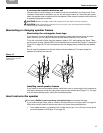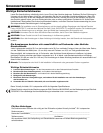
23
R
EFERENCE
English Français NederlandsDeutsch Italiano
• Never run speaker cord and electrical cable through the same hole or into the same
junction box.
• If a short section of the cord must run parallel to nearby electrical cable, keeping that run to
the absolute minimum will result in less interference.
• Use metal conduit or shielded speaker cord if the cord must run next to electrical cable for
10 ft. (3 m) or more.
• Use cable clamps or large wire staples to fasten the cord to a joist or stud wherever the
cord runs more than 4
1
/
2
ft. (1.4 m) from a hole.
• Use protective guard strips, raceways, or conduits to protect the cord from being stepped
on or compressed in an attic or crawl space.
Installing in a pre-wired room
An installation is simplest when the room has been pre-wired during construction. In that
case, the builder will have left speaker cord within easy reach of the intended speaker
positions. In the ideal situation, after cutting the speaker hole you can simply reach inside to
locate the length of cord the builder has installed.
If you are not sure that you have a pre-wired room, or do not know where the wiring is
located, check the architectural drawings of your room or call the builder.
CAUTION:
It is important to know where the pre-wired cord is to prevent damaging it while
drilling or cutting into the wall.
Where the walls are finished
Here are some suggestions for how to make this job easier.
Look for ways to conceal cord outside the walls (See Figure 27):
• Along or behind baseboards
• Under carpets (using special flat speaker cord for under-the-rug speaker runs)
• Under doorjambs.
Figure 27
Running cord behind
baseboards and a
doorjamb


















